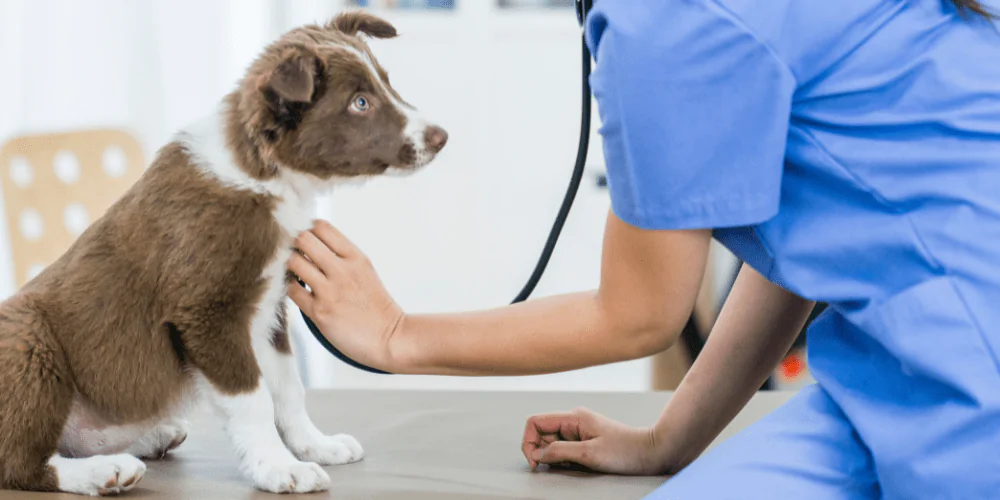
Is your dog sick? Here’s what to do

Dr Lily Richards BSc (Hons) BVSc MRCVS
30 November 2023 | 4 minutes read
Your best pet pal does an incredible job of brightening your day with their playful antics. But what happens when they feel under the weather and are not having a great day?
Join expert vet Dr Lily Richards as she delves into the telltale signs that your dog might be sick or feeling sad. Find out how to advocate for your pup’s well-being and bring them back to their tail-wagging selves.
- Why learn how to spot signs of illness in your dog
- How to tell if your dog is sick
> How to tell if your dog is sick or depressed
> How to tell if your dog is sick or tired - What to do if you think your dog is sick

Why learn how to spot signs of illness in your dog
Our dogs can’t tell us exactly what’s making them feel ill. That’s why it’s super important for us, as their caretakers, to be able to pick up on signs that something’s not right.
Learning to recognise the early signs of a poorly pup is important because:
- It can help you to pick up on any potential health problems before they get more severe
- Your dog may have more treatment options available, better outcomes, and a quicker recovery time
- It means your dog isn’t suffering for longer and dealing with extra pain and discomfort

How to tell if your dog is sick
Always keeping a close eye on your dog is a great way to spot when they’re not feeling their best.
Being their human, you know their personality and quirks, which can help you catch those moments when they seem even a little off.
Your dog’s symptoms might be subtle, like a change in their sleeping habits or energy levels. Others might be more obvious, like vomiting or diarrhoea.
Here’s some of the tell-tale signs that your dog might be sick:
- Excessive panting, gasping, trouble breathing, rapid breathing, or coughing
- Whining or whimpering
- Signs of aggression when being touched
- Excessive licking
- Limping or a change in activity level, trouble moving around, talking or jumping, or yelping when moving
- Lethargic behaviour such as lack of interaction or less interest in toys, slower on walks, or avoiding interaction
- Vomiting, followed by excessive dribbling, frequent vomiting, restlessness, and pacing
- Diarrhoea or constipation (changes in bowel habits)
- Bloating
- Increased thirst or weeing
- Reduced appetite
- Unusual smells from body parts, such as the claws
- Visible signs of wounds or bleeding
Don’t try to diagnose your dog yourself. It’s easy to misinterpret what’s wrong and potentially delay proper treatment. Speak to your vet for professional help about your pooch’s symptoms.

> How to tell if your dog is sick or depressed
Changes in behaviour are key to telling if your dog is sick or depressed – but it’s usually not straightforward.
A depressed dog might show similar physical symptoms to a sick one, like loss of appetite and lethargy.
But they’ll also show other behavioural signs, for example:
- Withdrawing from the family
- Being clingy
- A lack of interest in activities they once enjoyed, such as not wanting to go on walks or play with toys
- Excessive whining, barking or howling
A vet should always be your first port of call if your dog is showing any worrying symptoms or not acting like themselves.
If your vet can’t find anything medically wrong, reach out to a qualified behaviourist who’ll unpack what’s making your dog unhappy. For example, they may be feeling depressed due to separation anxiety.
> How to tell if your dog is sick or tired
It can be tricky to figure out if your dog is sick or just tired. Tired dogs can be lethargic but it’s a positive sign if they perk up after a good sleep.
Continued lethargic behaviour could suggest something more serious, so speak to your vet if you’re at all concerned.

What to do if you think your dog is sick
If you think your dog is sick, here’s what to do:
- Make a note of all your dog’s symptoms and when they started, ready to describe them to the vet. The more info you can give them, the better they can understand what’s wrong.
- It’s also worth noting down any questions you may want to ask your vet.
- Either take your pet to the vet clinic or – if offered by your pet insurance – start with an online video vet consultation.
- Run through what you’ve noticed about your pet’s health or behaviour with the vet. They’ll carry out a full health check and may need to do blood tests, x-rays, and other procedures as part of diagnosis.
It’s also helpful to know when you need to visit an emergency vet.
Be prepared for those unexpected vet trips for your poorly pup with flexible dog insurance from Petsure.


